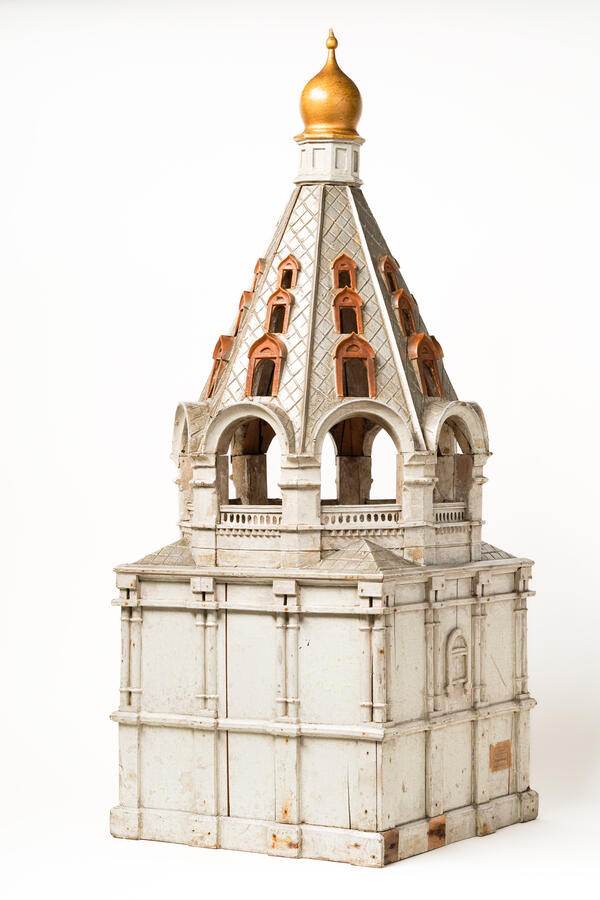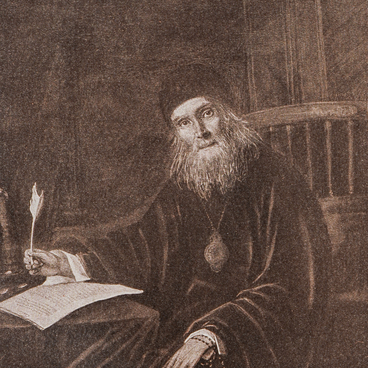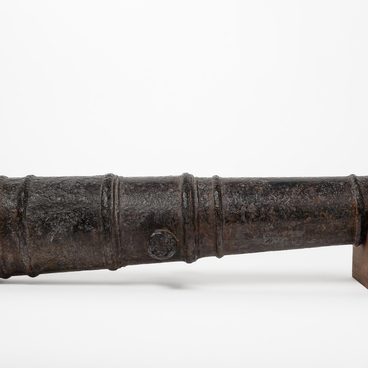The “Kolomna Kremlin” Museum-Reserve presents a model of the tented roof bell tower of the Assumption Cathedral dated from the 16th–17th centuries. The cathedral bell tower stands separately in the north-western part of Cathedral Square of the Kolomna Kremlin and plays a significant role in forming the architectural ensemble of the square.
According to the Kolomna local historian N.A. Roschina, the bell tower rests on the walls of the old Church of Nikola Zaraisky, which was built in memory of the “visitation” of the miracle-working icon of Nikola Zaraisky in Kolomna in 1513. This assumption is based on the drawing of the bell tower, made by Matvey Feodorovich Kazakov. It clearly shows some remnants of the Church in the lower tier of the bell tower. There appeared to have been a stone bell tower next to this church.
By the end of the 17th century the bell tower had fallen into disrepair and in 1692 a new one made of brick was built in its place. These events happened to coincide with the rebuilding of the dilapidated Cathedral of the Assumption of the Blessed Virgin Mary. The foundation of the cathedral was laid in Kolomna by Prince Dmitry Donskoy after the first major victory of the Russian forces over the Golden Horde in the battle on the Vozha River in 1378. The cathedral was reconstructed in the 17th century under Bishop Nikita, who had come from the Kirillo-Belozersky monastery. The tented roof bell tower was also erected during his time.
The bell tower, built in line with the tradition of the 17th century, stands out from its counterparts in terms of its extraordinary size. The massive cube of the base of the bell tower supports a broad octagonal bell chamber, topped by a tented roof with three rows of the “dormers”. The quadrangle is divided by planking into two tiers and is covered with the eight-part vault on the stepped squinches. In the center of it is a hollow cylinder with a spiral staircase leading to the bells. The unpretentious dry design of the facades with semi-columns, square decorative brickwork and cornices with curbs reveal the predominant importance of the architectural massing of this unremarkable construction.
In 1929, as a result of the Bolshevik campaign against religion, the Assumption Cathedral was ruined and the bells were dropped from the bell tower. The bell tower was reconstructed in 1962 with E. R. Kunitskaya in charge of the restoration works. In 1990 the bell tower was restored once again, and in December of the same year eight new bells were mounted there. The bell tower miraculously survived the Soviet era and is now a highly valued monument of the city’s architecture.
According to the Kolomna local historian N.A. Roschina, the bell tower rests on the walls of the old Church of Nikola Zaraisky, which was built in memory of the “visitation” of the miracle-working icon of Nikola Zaraisky in Kolomna in 1513. This assumption is based on the drawing of the bell tower, made by Matvey Feodorovich Kazakov. It clearly shows some remnants of the Church in the lower tier of the bell tower. There appeared to have been a stone bell tower next to this church.
By the end of the 17th century the bell tower had fallen into disrepair and in 1692 a new one made of brick was built in its place. These events happened to coincide with the rebuilding of the dilapidated Cathedral of the Assumption of the Blessed Virgin Mary. The foundation of the cathedral was laid in Kolomna by Prince Dmitry Donskoy after the first major victory of the Russian forces over the Golden Horde in the battle on the Vozha River in 1378. The cathedral was reconstructed in the 17th century under Bishop Nikita, who had come from the Kirillo-Belozersky monastery. The tented roof bell tower was also erected during his time.
The bell tower, built in line with the tradition of the 17th century, stands out from its counterparts in terms of its extraordinary size. The massive cube of the base of the bell tower supports a broad octagonal bell chamber, topped by a tented roof with three rows of the “dormers”. The quadrangle is divided by planking into two tiers and is covered with the eight-part vault on the stepped squinches. In the center of it is a hollow cylinder with a spiral staircase leading to the bells. The unpretentious dry design of the facades with semi-columns, square decorative brickwork and cornices with curbs reveal the predominant importance of the architectural massing of this unremarkable construction.
In 1929, as a result of the Bolshevik campaign against religion, the Assumption Cathedral was ruined and the bells were dropped from the bell tower. The bell tower was reconstructed in 1962 with E. R. Kunitskaya in charge of the restoration works. In 1990 the bell tower was restored once again, and in December of the same year eight new bells were mounted there. The bell tower miraculously survived the Soviet era and is now a highly valued monument of the city’s architecture.






